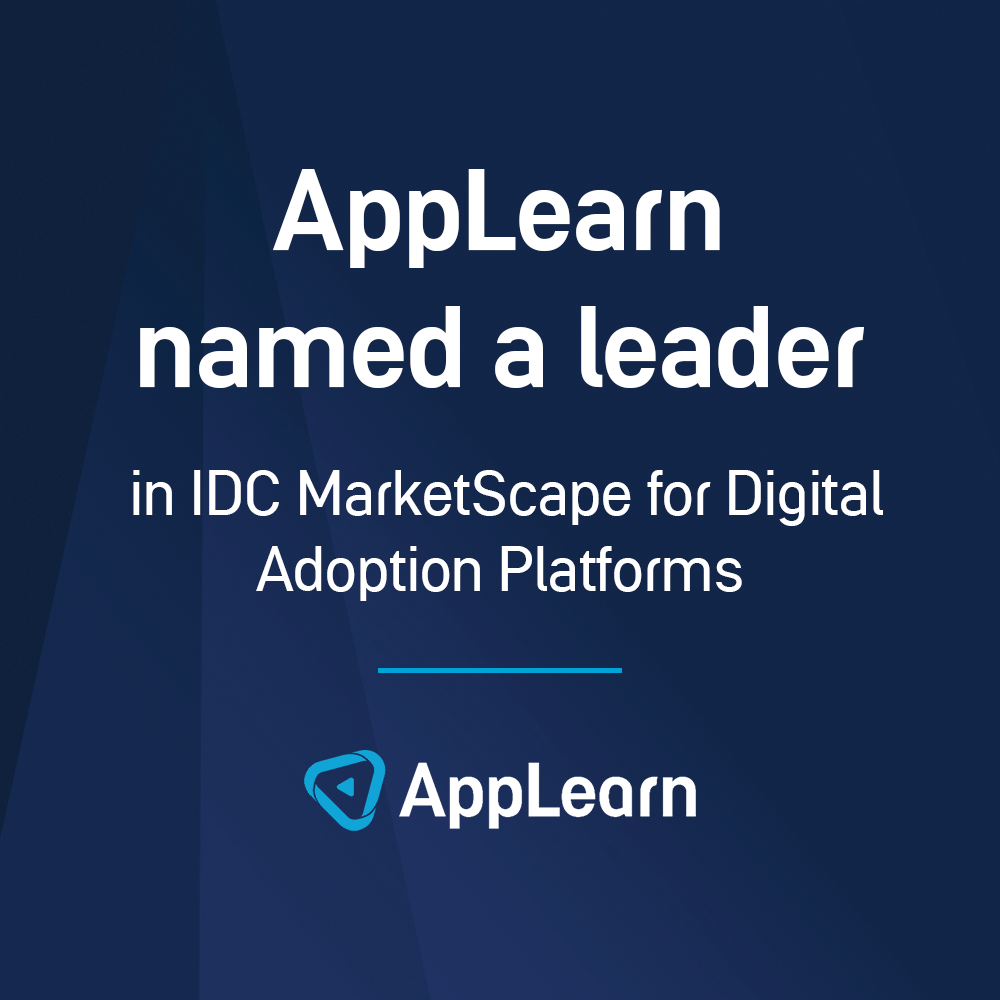News
3 lessons in HR software onboarding from businesses leading the way
3 lessons in HR software onboarding from businesses leading the way
How do you make sure your employees get the most out of your HR applications and systems? One area that can help is an effective software onboarding process. We spoke to leading organizations from across the globe about their experience of optimizing HR and HCM software for their people, sharing the lessons learned along the way.
HR and HCM technology is a multi-billion dollar industry, and its growth is expected to continue exponentially. This booming market growth reflects the rising popularity of systems like Workday, Cornerstone and SAP SuccessFactors. Many organizations are now using software to support the many responsibilities of HR departments, including personal information filing, performance and development documentation and leave requests, to name just a few.
It’s an increasingly tech-enabled area of work, and these applications aren’t just used by HR personnel. Nearly every member of an organization will have some interaction with these tools, even if the applications don’t relate to the actual delivery of their work.
What’s more, they’re unlikely to use these systems frequently. They may only log in once or twice a month to update personal info or flag a leave request. Sometimes only once a year to complete review-type processes. These interactions (or lack thereof) breed unfamiliarity – which can lead to problems using the software later down the line.
This makes it all the more odd that when non-HR employees are welcomed to an organization, they are rarely given thorough training or orientation on how to use the HCM or wider HR applications. And it is even rarer still for onboarding to be present, whether that’s on first access or an ongoing basis to account for interface updates and process changes.
Given how much is typically invested when rolling out these systems – least of all in the upfront licensing costs – can you afford for HR and HCM software onboarding to be an afterthought? The following organizations agreed with us and thought not, making sure they had a thorough software onboarding process in place when rolling out new HR systems across their global workforces.
Each saw great success, and they share their key learnings with us here: how analytics can uncover software onboarding wins, the value of personalizing the software training experience, and where to begin when streamlining HR tech support.
Cushman & Wakefield: Implementing personalized Workday training globally
As one of the world’s leading commercial real estate organizations, Cushman & Wakefield have a global workforce of over 47,000 employees across more than 60 countries. You can imagine how introducing new technologies (whether HR-focused or not) can prove a challenge. Throw a merger into the mix and the situation becomes even more complex.
At the time, Cushman & Wakefield had begun implementing Workday, enterprise software that supports key HR functions, amongst others. It marked a huge shift in culture, processes and task completion for Cushman & Wakefield’s substantial workforce, as employees across the globe attempted to get to grips with this new, cloud-based, system. Whilst some employees were technologically competent, not all had experience of using such tools – further complicating matters.
So, how did Cushman & Wakefield attempt to overcome some of these challenges? It came back to onboarding – making sure an employee’s interaction with the new application set them up for ongoing software success. Easier said than done when your workforce is 47,000+ strong though, right?
Cushman & Wakefield reached out to our team here at AppLearn. We specialize in digital adoption platforms (DAP) – technology that ensures businesses and their people get more value from software. Our DAP, Adopt, layers over chosen applications to monitor interactions, identify when and where software issues arise, and direct users to support as and when they need it. You can read how Adopt optimizes software onboarding processes here.
Back to Cushman & Wakefield. With our support, the brand was able to tailor Workday-specific support to every employee – no matter their location, role, skill level or tech savviness. This was delivered through training and communications that addressed the needs of specific employees. As Cushman & Wakefield’s CRM Program Owner and Change Lead, Mark Powell, put it: “The ability to give a consistent support experience to the end user and to push messaging as and when they come to tasks is extremely powerful, as users don’t get bombarded with unnecessary communications, but actually get the support as and when they need it.”
But how did this affect the adoption of Workday? We helped Cushman & Wakefield to measure the effectiveness of its implementation program through Adopt’s advanced analytics (more on this later). By getting its software onboarding processes set up in the right way, Cushman & Wakefield saw a 136% reduction in tickets, and delivered 532 days of continuous training seamlessly. You can find out more detail on our work with Cushman & Wakefield here, including a video with Mark discussing the project.
Electrolux: Using analytics and insights to get more out of Cornerstone
Electrolux is a leader in home appliances, designing and manufacturing appliances that are used around the world. The shift to remote and hybrid working, as a result of the pandemic, posed some key challenges for its internal HR teams – responsible for a 50,000+ workforce based across the globe. The organization wanted to ensure high employee engagement with its talent management program, underpinned by Cornerstone, another leading application that supports HR functions.
So, how could Electrolux begin to get to grips with how its many employees interacted with one of its key HR applications? Luckily, the organization had worked with AppLearn since 2017, using Adopt to support the initial roll out of Cornerstone.
Adopt’s analytics therefore played a key role in ensuring employees were getting the most out of their digital tools. By tracking and monitoring user interactions with the application in question, Adopt provides actionable insights that can be used to improve task completion, application workflows, and signposting of support, to name just a few areas.
In Electrolux’s case, it was able to mine years of Adopt-gathered data to build a holistic picture of how its employees engaged with Cornerstone. It enabled the digital HR teams to plan interventions when issues arose, particularly useful given the shift to remote working at the time. Electrolux was also able to observe user behavior in the lead up to processes such as salary reviews, adapting support delivered through Cornerstone accordingly.
Over the course of the project, Electrolux delivered 100,000 of application interventions, in turn saving thousands of productive hours by improving task completion and reducing the number of support tickets raised. By 2022, the brand saw a 130% user increase of Cornerstone, a 10% decrease in average task time completion, and a 104% improvement in self-service support. By seeing software onboarding as an ongoing process, where users require support and training interventions continually no matter how long they have used the system in question, Electrolux was able to get more out of its chosen HR application.
Christian Bengtsson-Rossby, Digital HR Director at Electrolux, summed it up well: “Adopt helps us to bring the best possible experience and adoption to [our HR platforms]. Adopt’s analytics give us concrete answers on what is and isn’t working for our employees and our administrators. With [it], we’re seeing less frustration from employees and managers.”
Want to hear more about how Adopt helped Electrolux unlock even more value from Cornerstone? Head to the dedicated Electrolux success story page here.
GKN Aerospace: Streamlining the delivery of support materials to drive SAP SuccessFactors uptake
World-leading aerospace supplier, GKN serves over 90% of the globe’s aircraft and engine manufacturers and is supported by a 15,000-strong team across 13 countries. The organization began exploring how technology could support its internal HR teams in 2018, deciding to roll out SAP SuccessFactors as a result; the HCM application is used globally to support the employee experience.
As you’d expect, rolling out a new application to a huge, global workforce is a daunting challenge. GKN had to navigate the shift from its existing applications to SAP SuccessFactors, and make sure its employees received the right support to onboard them quickly and effectively onto the system.
The organization reached out to AppLearn to explore how Adopt could help with these efforts, focusing on self-help training materials. We looked to optimize support collateral and communications that could be delivered as people navigated through the application, rather than asking users read long guides before even logging on.
GKN had a lot of these materials to hand already, but they were scattered outside of the old system. We modernized the format and placement of these, and also considered people’s location and role, as this would influence how and when they might engage with training materials. Adopt’s pop-up Smart Pages enabled GKN to target people with support as they completed key tasks, making associated materials available in a split screen. The delivery of training materials was driven by analytics gathered by Adopt, making sure it reached users as and when they most needed it – and were therefore more likely to engage with support.
As a result of this contextual support, delivered at a crucial stage of the software onboarding process, GKN saw 91% user engagement with in-app process reminders and 85% usage of in-app tips. The brand also found that users were four times more likely to perform key tasks after viewing a pop-up reminder delivered in-app by Adopt.
Willy Holdahl, Global Head of Change Management – HR at GKN Aerospace, shared with us: “AppLearn’s platform lets us put self-help training materials in SuccessFactors and get data on how our employees are using it. We can use the data to measure where we need to put in new training, improve materials or help employees to be as efficient as possible.”
If you’re interested you can read more about GKN’s success here, and even hear from them in a video interview.
So, there you have it. Years of expertise and experimentation distilled into three core lessons:
- Use analytics to uncover onboarding wins and weak points
- Streamline the delivery of support materials so it’s easy for end-users from day one
- Personalize your support, even when rolling out globally
Whether you intend to invest in any of these areas (and you should, it’s what our digital adoption platform is designed for) or not, applying these lessons will set you on the right path to more successful software.
Article by
Daniel Gripton
Share this article





